#western fashion history
Explore tagged Tumblr posts
Text

So I got this tag on my answer to an ask about when it became acceptable for western women to wear pants, and you know it's all I need to go on a tangent.
I think the short answer here would be men have worn skirts as long as people have worn anything, so pretty long tbh. But since I am incapable of answering anything shortly, I think we can re-frame this question:
When did skirts stop being socially acceptable for men?
So let's start with acknowledging that tunics, togas, kirtles and such men wore through history were, in fact, skirts. I think there's often a tendency to think of these as very different garments from those that women wore, but really they are not. Most of the time they were literally referred to with the same name. (I will do a very broad and simplified overview of men's clothing from ancient times to Early Middle Ages so we can get to the point which is Late Middle Ages.)
Ancient Greek men and women both wore chitons. Even it's length wasn't determined by gender, but by occupation. Athletes, soldiers and slaves wore knee-length chitons for easier movement. Roman men and women wore very similar garment, tunics. Especially in earlier ancient Rome long sleeves were associated with women, but later became more popular and unconventional for men too. Length though was still dependent on occupation and class, not gender. Toga was sure men's clothing, but worn over tunic. It was wrapped around the waist, like a dress would, and then hung over shoulder. Romans did wear leggings when they needed to. For example for leg protection when hunting as in this mosaic from 4th century. They would have been mostly used by men since men would be doing the kinds of activities that would require them. But that does not lessen the dressyness of the tunics worn here. If a woman today wears leggings under her skirt, the skirt doesn't suddenly become not a skirt.

All over Europe thorough the early Middle Ages, the clothes were very similar in their basic shape and construction as in Rome and Greece. In Central and Northern Europe though people would wear pants under shorter tunics. There were exceptions to the everyone wearing a tunic trend. Celtic men wore braccae, which were pants, and short tunics and literally just shirts. Celts are the rare case, where I think we can say that men didn't wear dresses. Most other peoples in these colder areas wore at least knee-length tunics. Shorter tunics and trousers were worn again mostly by soldiers and slaves, so rarely any other woman than slave women. The trousers were though definitely trousers in Early Middle Ages. They were usually loose for easier construction and therefore not that similar to Roman leggings. However leggings style fitted pants were still used, especially by nobility. I'd say the loose trousers are a gray area. They wore both dresses and pants, but still definitely dresses. I'd say this style was very comparable to the 2000s miniskirts over jeans style. First one below is a reconstruction of Old Norse clothing by Danish history museum. The second is some celebrity from 2005. I see no difference.
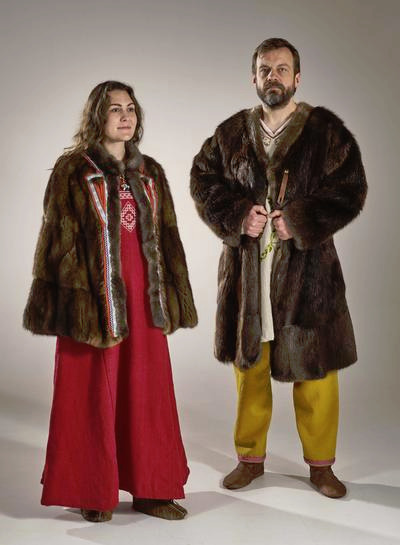
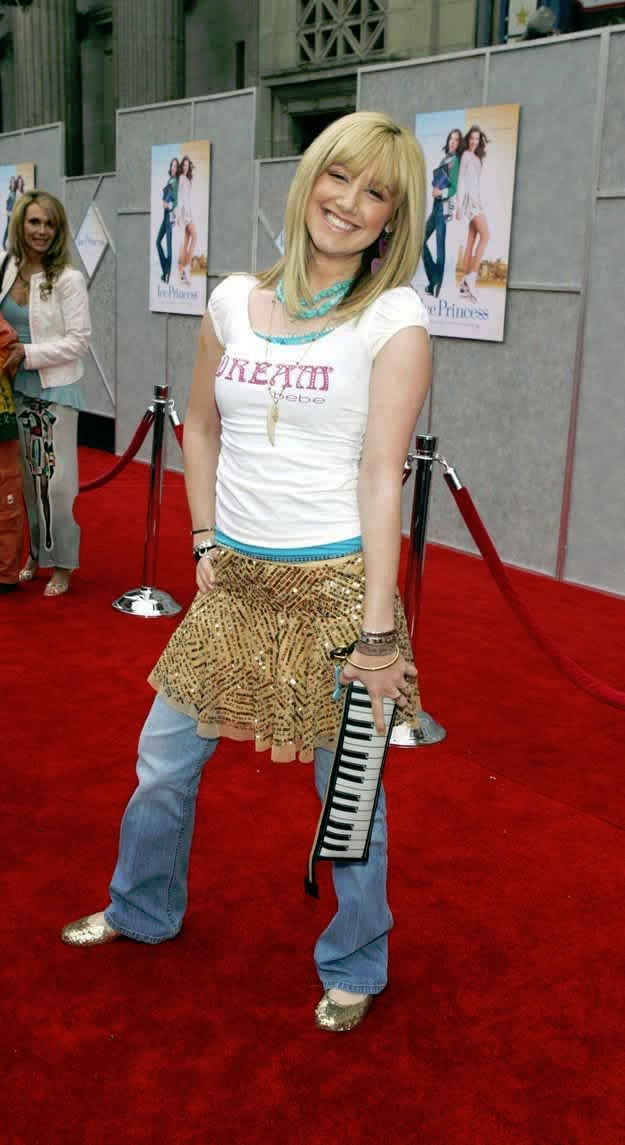
When we get to the high Middle Ages tunics are still used by both men and women, and still it's length is dependent on class and activity more than gender, but there's some new developments too. Pants and skirt combo is fully out and leggings' are back in in form of hose. Hose were not in fact pants and calling them leggings is also misleading. Really they are socks. Or at least that's how they started. As it has become a trend here they were used by everyone, not just men. During early Middle Ages they were worn often with the trousers, sometimes the trousers tucked inside them making them baggy. In high Middle Ages they became very long when used with shorter tunics, fully displacing the need for trousers. They would be tied to the waist to keep them up, as they were not knitted (knitting was being invented in Egypt around this time, and some knitting was introduced to Europe during middle Ages, but it really only took off much later during Renaissance Era) and therefore not stretchy. First picture is an example of that from 1440s. Another exciting development in the High Medieval era was bliaut in France and it's sphere of influence. Bliaut was an early attempt in Europe of a fitted dress. And again used by both men and women. The second illustration below from mid 12th century shows a noble man wearing a bliaut and nicely showing off his leg covered in fitted hose. Bliaut was usually likely fitted with lacing on the sides, but it wasn't tailored (tailoring wasn't really a thing just yet) and so created a wrinkled effect around the torso.
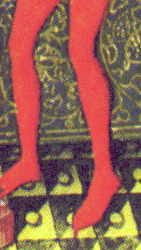

In the 14th century things really picked up in European fashion. European kingdoms finally started to become richer and the rich started to have some extra money to put into clothing, so new trends started to pop up rapidly. Tailoring became a thing and clothes could be now cut to be very fitted, which gave birth to fitted kirtle. At the same time having extra money meant being able to spend extra money on more fabric and to create very voluminous clothing, which gave birth to the houppelande.
Kirtle was once again worn by everyone. It wasn't an undergarment, for women that would be shift and men shirt and breeches, but it was an underlayer. It could be worn in public but often had at least another layer on top of it. The bodice part, including sleeves were very fitted with lacing or buttons (though there were over-layer kirtles that had different sleeves that changed with fashions and would be usually worn over a fitted kirtle). Men's kirtles were short, earlier in 14th century knee-length but towards the end of the century even shorter styles became fashionable in some areas. First picture below shows a man with knee-length kirtle from 1450s Italy.
Houppelande was also unisex. It was a loose full-length overgown with a lot of fabric that was gathered on the neckline and could be worn belted or unbelted. The sleeves were also wide and became increasingly wider (for men and women) later in the century and into the next century. Shorter gowns similar in style and construction to the houppelande were also fashionable for men. Both of these styles are seen in the second picture below from late 14th century.
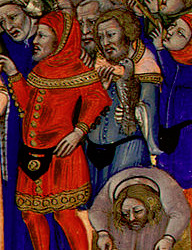
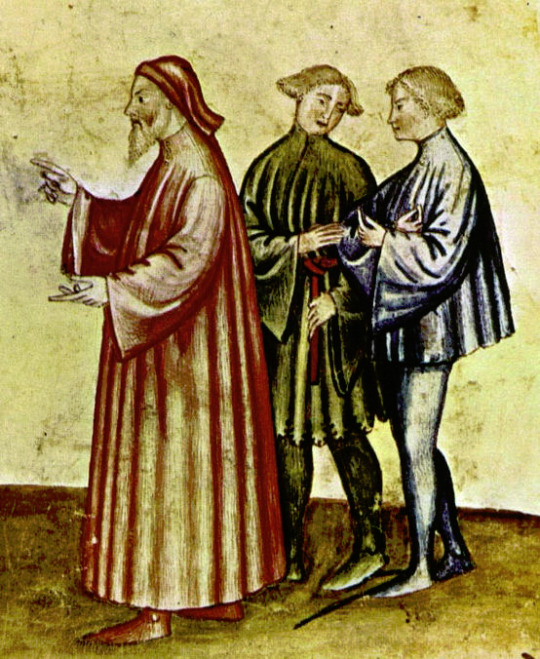
In the very end of 14th century, first signs of pantification of men can be seen. In France and it's sphere of influence the skirt part of the kirtle became so short it barely covered the breeches as seen below on these fashionable musicians from 1395-1400 France. Long houppelandes, length ranging from floor to calf, were still used by men though (the second picture, 1414 France), as were knee and thigh length gowns of similar loose style.

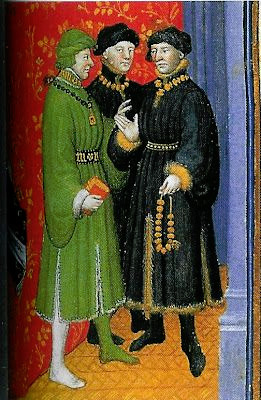
The hems continued to be short through the 15th century in France, but in other places like Italy and German sphere of influence, they were still fairly long, at least to mid thigh, through the first half of the century. In France at some point in late 13th century the very short under-kirtle started to be called doublet and they are just getting shorter in 1400s. The showing underwear problem was fixed by joined hose and the codpiece, signaling the entrance of The Sluttiest Era of men's fashion. Below is an example from 1450s Belgium of doublet and early codpiece in display. As you can see from the other figures, the overgowns of the previous century were also getting very, very short. In the next French example below from 1470s we can see the skirt shrink out of existence right before our eyes.
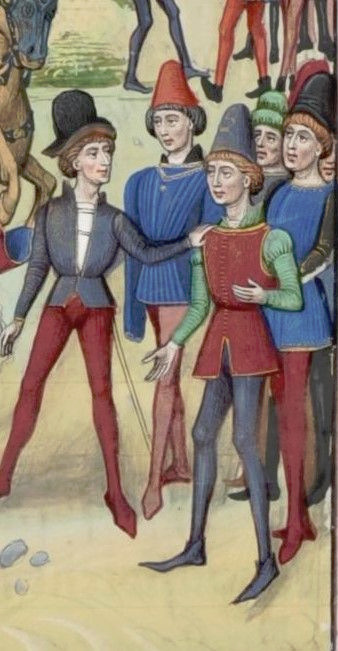
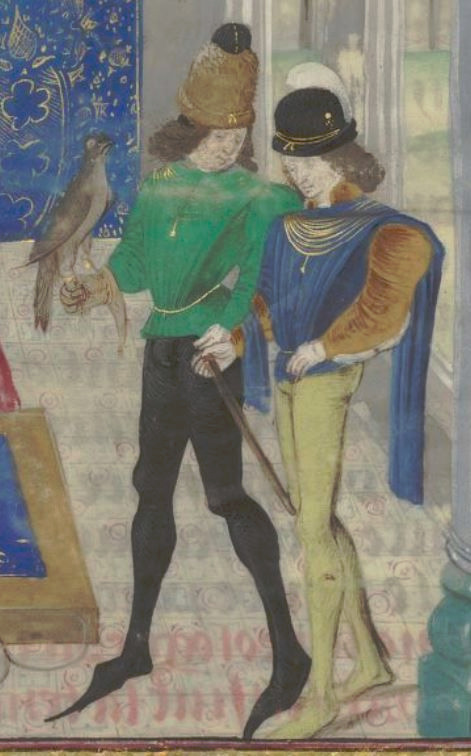
The very skimpy doublet and it's accompanying codpiece spread to the rest of the Europe in the second half of 15th century and it would only get sluttier from there. The Italians were just showing their full ass (example from 1490s). The dress was not gone yet though. The doublet and codpiece continued to be fashionable, but the overdress got longer again in the French area too. For example in the second example there's Italian soldiers in a knee length dresses from 1513.
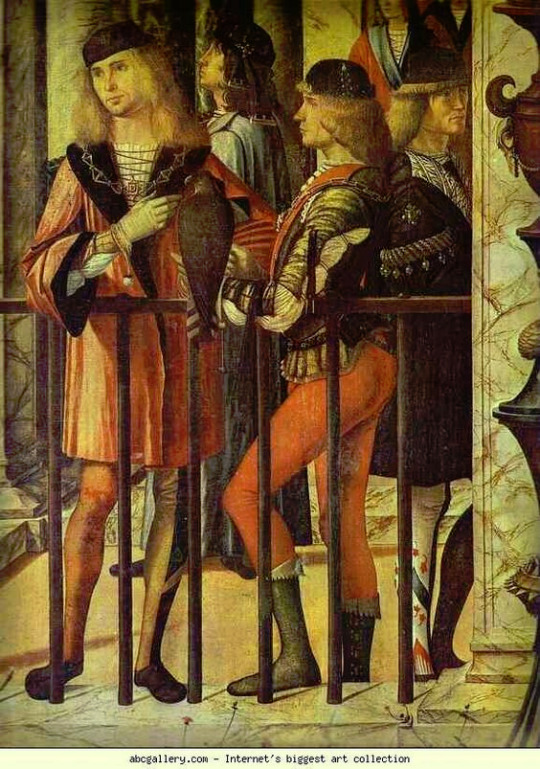

But we have to talk about the Germans. They went absolutely mad with the whole doublet and codpiece. Just look at this 1513 painting below (first one). But they did not only do it sluttier than everyone else, they also changed the course of men's fashion.
Let's take a detour talking about the Landsknecht, the mercenary pikeman army of the Holy Roman Empire. (I'm not that knowledgeable in war history so take my war history explanation with a grain of salt.) Pikemen had recently become a formidable counter-unit against cavalry, which earlier in the Medieval Era had been the most important units. Knights were the professional highly trained cavalry, which the whole feudal system leaned against. On the other hand land units were usually not made of professional soldiers. Landsknecht were formed in late 15th century as a professional army of pikemen. They were skilled and highly organized, and quickly became a decisive force in European wars. Their military significance gave them a lot of power in the Holy Roman Empire, some were even given knighthood, which previously wasn't possible for land units, and interestingly for us they were exempt from sumptuary laws. Sumptuary laws controlled who could wear what. As the bourgeois became richer in Europe in late Middle Ages and Renaissance Era, laws were enacted to limit certain fabrics, colors and styles from those outside nobility, to uphold the hierarchy between rich bourgeois and the nobles. The Landsknecht, who were well payed mercenaries (they would mutiny, if they didn't get payed enough), went immediately absolute mad with the power to bypass sumptuary laws. Crimes against fashion (affectionate) were committed. What do you do, when you have extra money and one of your privileges is to wear every color and fabric? You wear every color and fabric. At the same time. You wear them on top of each other and so they can be seen at the same time, you slash the outer layer. In the second image you can feast your eyes on the Landsknecht.

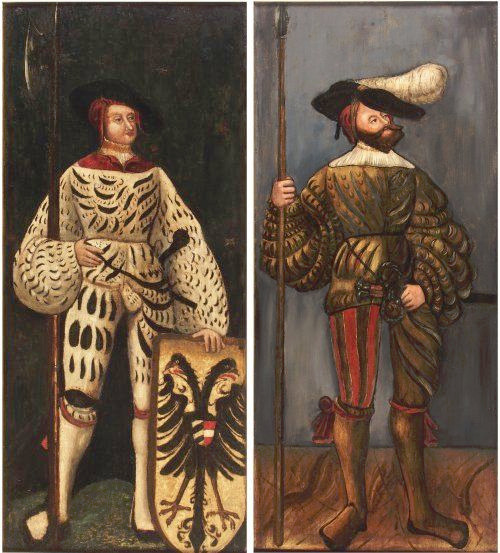
Just to give you a little more of that good stuff, here's a selection of some of my favorite Landsknecht illustrations. This is the peak male performance. Look at those codpieces. Look at those bare legs. The tiny shorts. And savor them.
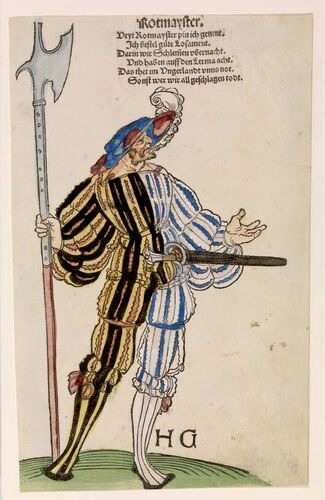
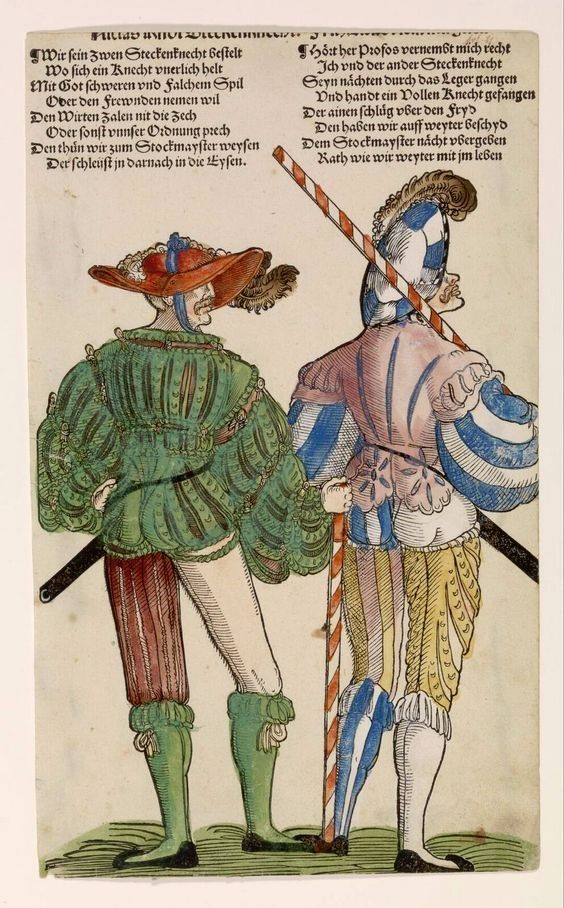
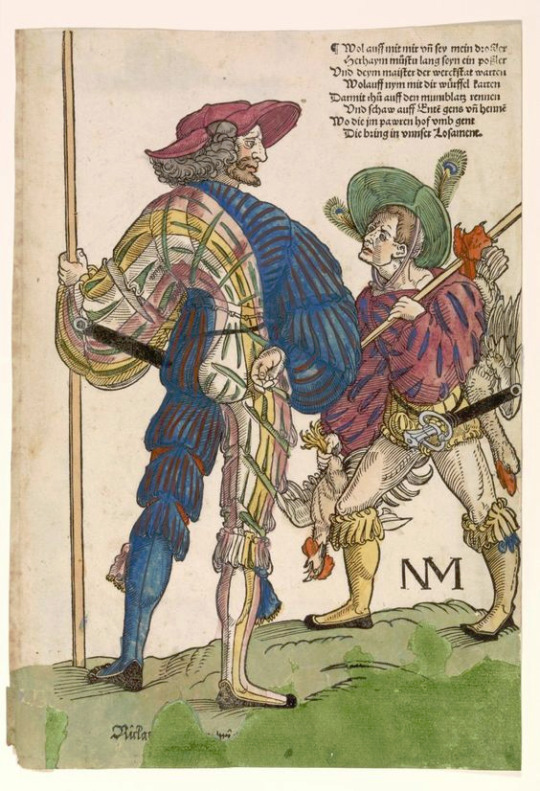
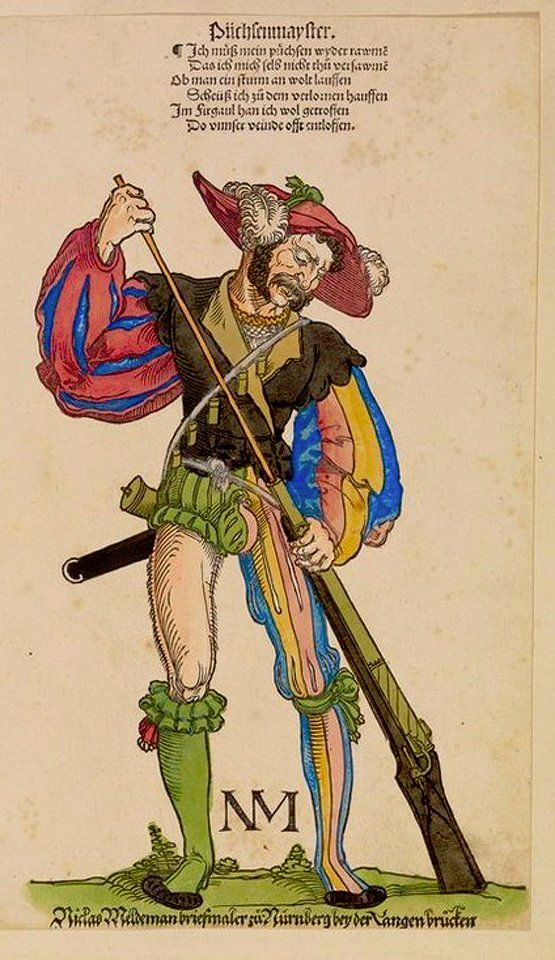
The Landsknecht were the hot shit. Their lavish and over the top influence quickly took over men's fashion in Germany in early 1500s. Slashing, the technique possibly started by them, but at least popularized by them, instantly spread all over Europe. That's how you get the typical Renaissance poof sleeves. They at first slashed the thighs of their hose, but it seems like to fit more of everything into their outfits, they started wearing the hose in two parts, upper hose and nether hose, which was a sort of return to the early Medieval trousers and knee-high hose style. The two part hose was adopted by the wider German men's fashion early in the century, but already in 1520s had spread to rest of Europe. It was first combined with the knee-length overdress that had made it's comeback in the turn of the century, like in this Italian painting from 1526 (first image). At this point knitting had become established and wide-spread craft in Europe and the stockings were born, replacing nether hose. They were basically nether hose, but from knitted fabric. The gown shortened again and turned into more of a jacket as the trunk hose became increasingly the centerpiece of the outfit, until in 1560s doublet - trunk hose combination emerged as the standard outerwear (as seen in the second example, 1569 Netherlands) putting the last nail on the coffin of the men's dress as well as the Sluttiest Era. The hose and doublet became profoundly un-slutty and un-horny, especially when the solemn Spanish influence spread all over with it's dark and muted colors.

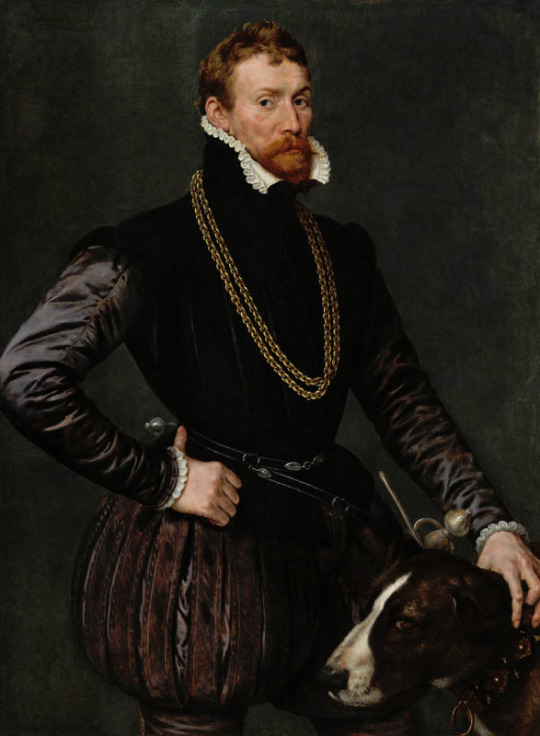
Especially in Middle Ages, but thorough European history, trousers have been associated with soldiers. The largely accepted theory is that trousers were invented for horse riding, but in climates with cold winters, where short skirts are too cold, and long skirts are still a hazard when moving around, trousers (with or without a short skirt) are convenient for all kinds of other movement requiring activities like war. So by adopting hose as general men's clothing, men in 1500s associated masculinity with militarism. It was not a coincidence that the style came from Landsknecht. I may have been joking about them being "peak male performance", but really they were the new masculine ideals for the new age. At the time capitalism was taking form and European great powers had begun the process of violently conquering the world for money, so it's not surprising that the men, who fought for money and became rich and powerful doing so, were idealised.
Because of capitalism and increasingly centralized power, the feudal system was crumbling and with it the feudal social hierarchy. Capitalism shifted the wealth from land ownership (which feudal nobility was built upon) to capital and trade, deteriorating the hierarchy based on land. At the same time Reformation and centralized secular powers were weakening the power of the Church, wavering also the hierarchy justified by godly ordain. The ruling class was not about to give up their power, so a new social hierarchy needed to form. Through colonialism the concept of race was created and the new hierarchy was drawn from racial, gender and wealth lines. It was a long process, but it started in 1500s, and the increasing distinction between men's and women's fashions was part of drawing those lines. At the same time distinctions between white men and racialized men, as well as white women and racialized women were drawn. As in Europe up until this point, all over the world (with some exceptions) skirts were used by everyone. So when European men fully adopted the trousers, and trousers, as well as their association to military, were equated with masculinity, part of it was to emasculate racialized men, to draw distinctions.
Surprise, it was colonialism all along! Honestly if there's a societal or cultural change after Middle Ages, a good guess for the reason behind it is always colonialism. It won't be right every time, but quite a lot of times. Trousers as a concept is of course not related to colonialism, but the idea that trousers equal masculinity and especially the idea that skirts equal femininity are. So I guess decolonize masculinity by wearing skirts?
#this has been sitting in my drafts almost finished for like a year or something#historical fashion#fashion history#fashion#history#dress history#men's historical fashion#renaissance fashion#medieval fashion#western fashion#western fashion history#landsknecht
3K notes
·
View notes
Text

Rock Hudson and James Dean on set of "Giant" (1956) photographed by Richard C. Miller
#rock hudson#james dean#giant#1950s hollywood#vintage hollywood#old hollywood#hollywood#western#richard c. miller#gay history#lgbt history#lgbtq history#vintage fashion#male style#movie history#male fashion
323 notes
·
View notes
Text
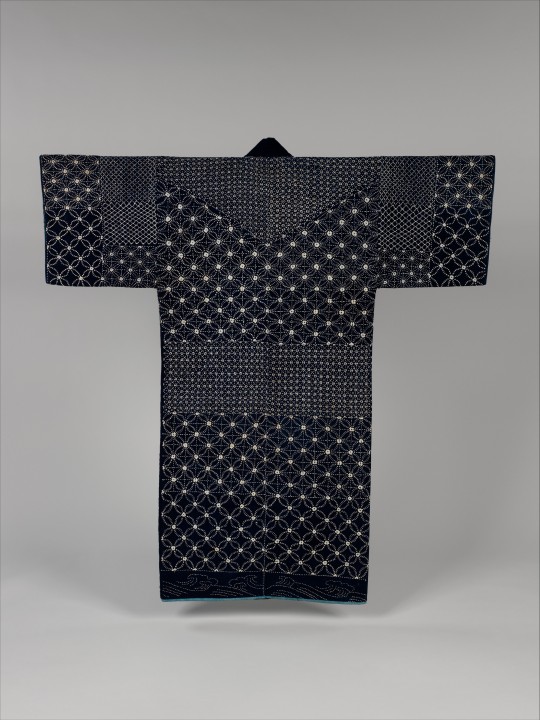

Sashiko Jacket
1850-1899 (Meiji Era)
Japan
Sashiko is a quilting technique that uses a running stitch to reinforce and prolong the life of a textile or to join together recycled pieces of cloth into a new garment. Japanese farmers used the technique to create warmer and more durable fabrics, and decorative sashiko stitching developed from this practical function. This robe’s embroidered design is dominated by three variations on the pattern of interlocking circles, called shippō-tsunagi. The bottom band features a design of waves.
The MET (Accession Number: 67.172.1)
#sashiko#fashion history#historical fashion#japanese fashion#non western fashion#japanese art#19th century#meiji era#quilting#japan#blue#off white#cotton#robe#jacket#1850s#1860s#1870s#1880s#1890s#the met
2K notes
·
View notes
Text
[Hanfu · 漢服]Chinese Western Han (202 BC – 9 AD) Traditional Clothing Hanfu Photoshoot
“这个位子 我有何坐不得?” “我欲问鼎天下,试问谁与争锋”
"Why can't I sit in this seat?"
"I want to conquer the world, who can compete with me?"
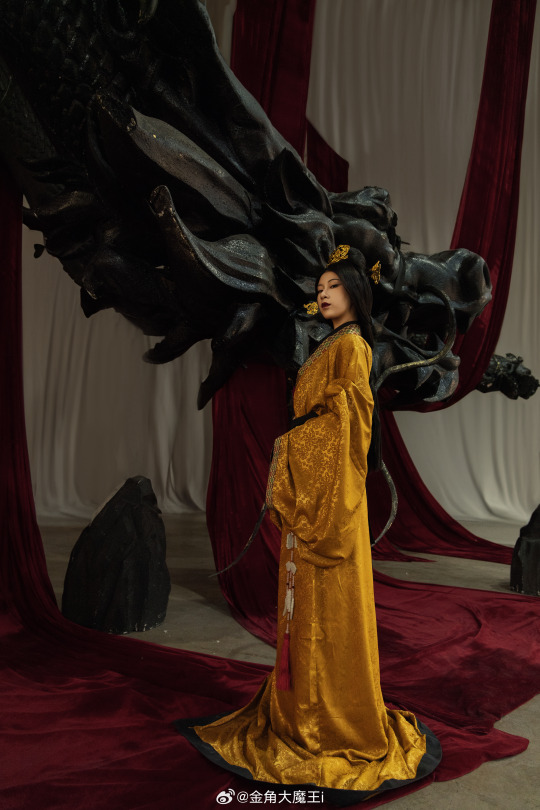
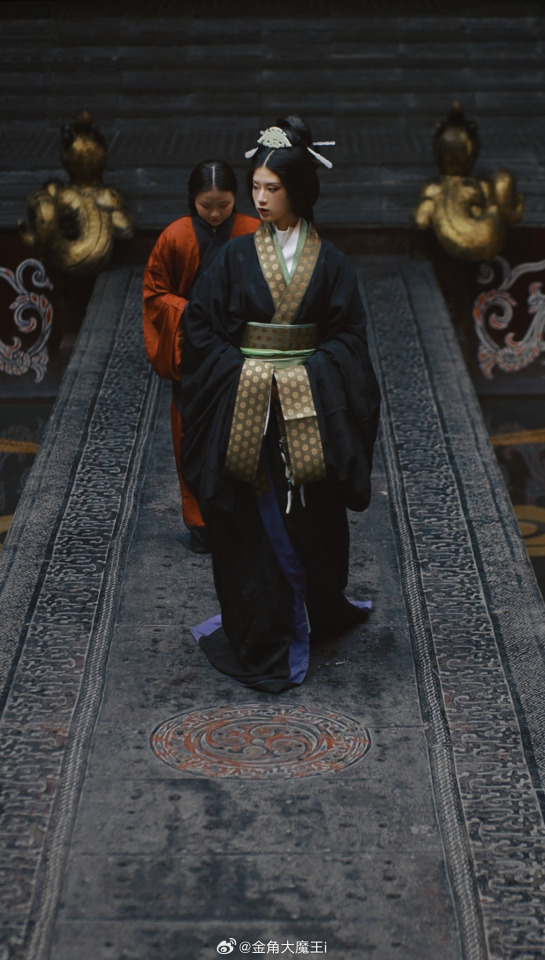
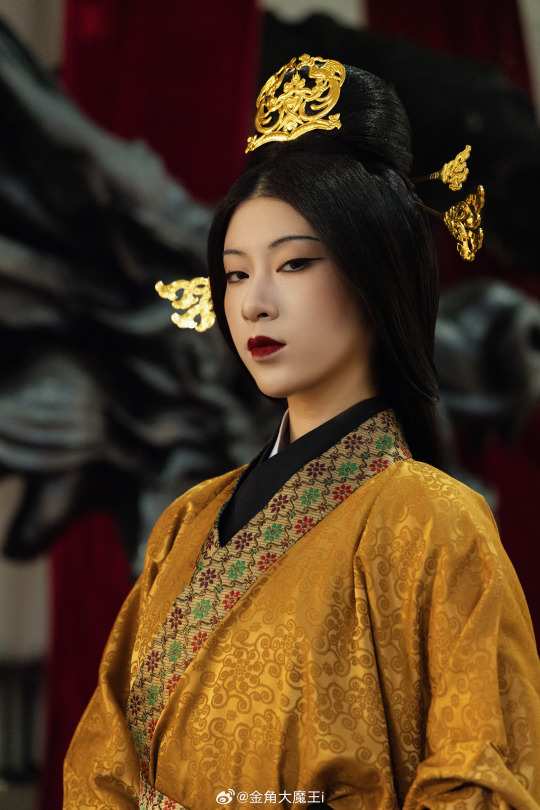
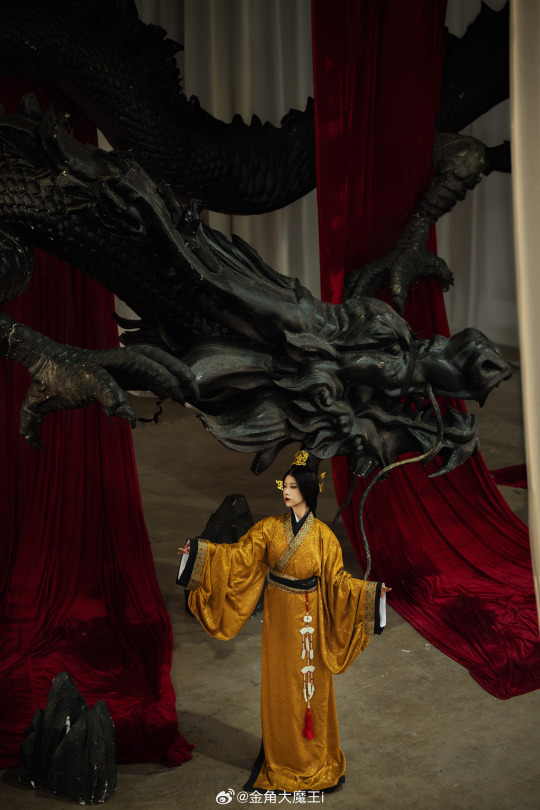

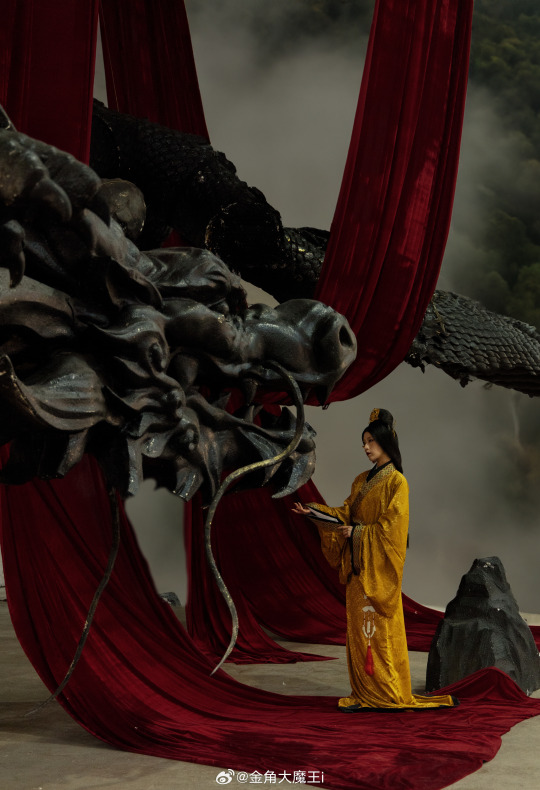


【About The First Empress of the Han Dynasty Empress Lü:Lǚ zhì(吕雉)】
Lü Zhi (241–18 August 180 BC), courtesy name E'xu (娥姁) and commonly known as Empress Lü (traditional Chinese: 呂后; simplified Chinese: 吕后; pinyin: Lǚ Hòu) and formally Empress Gao of Han (漢高后; 汉高后; Hàn Gāo Hòu), was the empress consort of Gaozu, the founding emperor of the Han dynasty. They had two known children, Liu Ying (later Emperor Hui of Han) and Princess Yuan of Lu. Lü was the first woman to assume the title Empress of China and paramount power. After Gaozu's death, she was honoured as empress dowager and regent during the short reigns of Emperor Hui and his successors Emperor Qianshao of Han and Liu Hong (Emperor Houshao).
She played a role in the rise and foundation of her husband, Emperor Gaozu, and his dynasty, and in some of the laws and customs laid down by him. Empress Lü, even in the absence of her husband from the capital, killed two prominent generals who played an important role in Gaozu's rise to power, namely Han Xin and Peng Yue, as a lesson for the aristocracy and other generals. In June 195 BC, with the death of Gaozu, Empress Lü became, as the widow of the late emperor and mother of the new emperor, Empress Dowager (皇太后, Huángtàihòu), and assumed a leadership role in her son's administration. Less than a year after Emperor Hui's accession to the throne, in 194 BC, Lü had one of the late Emperor Gaozu's consorts whom she deeply hated, Concubine Qi, put to death in a cruel manner. She also had Concubine Qi's son Liu Ruyi poisoned to death. Emperor Hui was shocked by his mother's cruelty and fell sick for a year, and thereafter no longer became involved in state affairs, and gave more power to his mother. As a result, Empress dowager Lü held the court, listened to the government, spoke on behalf of the emperor, and did everything (臨���聽政制, "linchao ting zhengzhi"). With the untimely death of her 22-year-old son, Emperor Hui, Empress dowager Lü subsequently proclaimed his two young sons emperor (known historically as Emperor Qianshao and Emperor Houshao respectively). She gained more power than ever before, and these two young emperors had no legitimacy as emperors in history; the history of this 8-year period is considered and recognized as the reign of Empress Dowager Lü. She dominated the political scene for 15 years until her death in August 180 BC, and is often depicted as the first woman to have ruled China. While four women are noted as having been politically active before her—Fu Hao, Yi Jiang, Lady Nanzi, and Queen Dowager Xuan—Lü was the perhaps first woman to have ruled over united China.
Lü Zhi was born in Shanfu County (單父; present-day Shan County, Shandong) during the late Qin Dynasty. Her courtesy name was Exu (Chinese: 娥姁; pinyin: Éxǔ). To flee from enemies, her father Lü Wen (呂文) brought their family to Pei County, settled there, and became a close friend of the county magistrate. Many influential men in town came to visit Lü Wen. Xiao He, then an assistant of the magistrate, was in charge of the seating arrangement and collection of gifts from guests at a banquet in Lü Wen's house, and he announced, "Those who do not offer more than 1,000 coins in gifts shall be seated outside the hall." Liu Bang (later Emperor Gaozu of Han), then a minor patrol officer (亭長), went there bringing a single cent and said, "I offer 10,000 coins." Lü Wen saw Liu Bang and was so impressed with him on first sight, that he immediately stood up and welcomed Liu into the hall to sit beside him. Xiao He told Lü Wen that Liu Bang was not serious, but Liu ignored him and chatted with Lü. Lü Wen said, "I used to predict fortunes for many people but I've never seen someone so exceptional like you before." Lü Wen then offered his daughter Lü Zhi's hand in marriage to Liu Bang and they were wed. Lü Zhi bore Liu Bang a daughter (later Princess Yuan of Lu) and a son, Liu Ying (later Emperor Hui of Han).
Liu Bang later participated in the rebellion against the Qin Dynasty under the insurgent Chu kingdom, nominally-ruled by King Huai II. Lü Zhi and her two children remained with her father and family for most of the time during this period.
Even after Emperor Gaozu (Liu Bang)'s victory over Xiang Yu, there were still unstable areas in the empire, requiring the new government to launch military campaigns to pacify these regions thereafter. Gaozu placed Empress Lü Zhi and the crown prince Liu Ying (Lü Zhi's son) in charge of the capital Chang'an and making key decisions in court, assisted by the chancellor Xiao He and other ministers. During this time, Lü Zhi proved herself to be a competent administrator in domestic affairs, and she quickly established strong working relationships with many of Gaozu's officials, who admired her for her capability and feared her for her ruthlessness. After the war ended and Emperor Gaozu returned, she remained in power and she was always influential in many of the country's affairs.
In his late years, Emperor Gaozu started favouring one of his younger consorts, Concubine Qi(戚夫人), who bore him a son, Liu Ruyi, who was instated as Prince of Zhao in 198 BC, displacing Lü Zhi's son-in-law Zhang Ao (Princess Yuan of Lu's husband). Gaozu had the intention of replacing Liu Ying with Liu Ruyi as crown prince, reasoning that the former was too "soft-hearted and weak" and that the latter resembled him more. Since Lü Zhi had strong rapport with many ministers, they generally opposed Gaozu's decision but the emperor seemed bent on deposing Liu Ying. Lü Zhi became worried and she approached Zhang Liang for help, and the latter analysed that Gaozu was changing the succession on grounds of favouritism. Zhang Liang invited the "Four Whiteheads of Mount Shang", a group of four reclusive wise men, to persuade Gaozu to change his decision. The four men promised to assist Liu Ying in future if he became emperor, and Gaozu was pleased to see that Liu Ying had their support. Gaozu told Concubine Qi, "I wanted to replace (the crown prince). Now I see that he has the support of those four men; he is fully fledged and difficult to unseat. Empress Lü is really in charge!" This marked the end of the dispute over the succession and affirmed Liu Ying's role as crown prince.
In June 195 BC, Emperor Gaozu died and was succeeded by Liu Ying, who became historically known as Emperor Hui of Han. Lü Zhi was honoured by Emperor Hui as empress dowager. She exerted more influence during the reign of her son than she had when she was empress, and she became the powerful and effective lead figure in his administration.
Lü Zhi did not harm most of Gaozu's other consorts and treated them according to the rules and customs of the imperial family. For example, consorts who bore male children that were instated as princes were granted the title of "Princess Dowager" (王太妃) in their respective sons' principalities. One exception was Concubine Qi, whom Lü Zhi greatly resented because of the dispute over the succession between Liu Ruyi (Qi's son) and Liu Ying. Liu Ruyi, the Prince of Zhao, was away in his principality, so Lü Zhi targeted Concubine Qi. She had Qi stripped of her position, treated like a convict (head shaved, in stocks, dressed in prison garb), and forced to do hard labour in the form of milling rice.
Roles in the deaths of Concubine Qi and Liu Ruyi
Lü Zhi then summoned Liu Ruyi, who was around the age of 12 then, to Chang'an, intending to kill him together with his mother. However Zhou Chang (周昌), the chancellor in Liu Ruyi's principality, whom Lü Zhi respected because of his stern opposition to Emperor Gaozu's proposal to make Liu Ruyi crown prince, temporarily protected Liu Ruyi from harm by responding to Lü Zhi's order that, "The Prince of Zhao is ill and unfit for travelling over long distances." Lü Zhi then ordered Zhou Chang to come to the capital, had him detained, and then summoned Liu Ruyi again. Emperor Hui tried to save Liu Ruyi by intercepting his half-brother before the latter entered Chang'an, and kept Liu Ruyi by his side most of the time. Lü Zhi refrained from carrying out her plans for several months because she feared that she might harm Emperor Hui as well.
One morning in the winter of 195-194 BC, Emperor Hui went for a hunting trip and did not bring Liu Ruyi with him because the latter refused to get out of bed. Lü Zhi's chance arrived, so she sent an assassin to force poisoned wine down Liu Ruyi's throat. The young prince was dead by the time Emperor Hui returned. Lü Zhi then had Concubine Qi killed in an inhumane manner: she had Qi's limbs chopped off, eyes gouged out, ears sliced off, nose sliced off, tongue cut out, forced her to drink a potion that made her mute, and had her thrown into a latrine. She called Qi a "human swine" (人彘). Several days later, Emperor Hui was taken to view the "human swine" and was shocked to learn that it was Concubine Qi. He cried loudly and became ill for a long time. He requested to see his mother and said, "This is something done not by a human. As the empress dowager's son, I'll never be able to rule the empire" From then on, Emperor Hui indulged himself in carnal pleasures and ignored state affairs, leaving all of them to his mother, and this caused power to fall completely into her hands.
When Lu first came to the court, she planned to establish the Lu family members as "kings (nobles)". This was not only to commemorate her deceased relatives, but also to strengthen her power in the court. However, Wang Ling, the prime minister at the time, immediately pointed out that the great ancestor Liu Bang(Husband of Lu, founding emperor of Han Dynasty)once killed the white horse and agreed that "if someone who are not Liu family be come the king, the whole world should attack them." Therefore, the move of establishing a foreign surname as the king violated the ancestral system established by Liu Bang and was really inappropriate.
Faced with the obstruction of Wang Ling, Empress Lu responded by deposing him and insisting on honoring her deceased father and two brothers as King Lu Xuan, King Wu Wu, and King Zhao Zhao. After setting this precedent, Lu was out of control. She not only named her three nephews Lu Tai, Lu Chan, and Lu Lu as King Lu, King Liang, and King Zhao respectively, but also named her grandnephew Lu Tong. He was the King of Yan, and his grandson Zhang Yan was granted the title of King of Lu.
In addition, there are also quite a few people with the surname Lu who have been granted the title of marquis. As a result, it can be said that many princes surnamed Lu appeared in the court in the blink of an eye. They controlled the government and became the cornerstone and support for Empress Lu to control the right to speak in the court.
Empress Lu's life was emblematic of the intricate power dynamics of the Han Dynasty in ancient China. Born into a modest family, Lu rose to prominence through her marriage to Emperor Gaozu. Her astute political acumen and strategic alliances allowed her to wield significant influence behind the throne. As the mother of several emperors, she orchestrated their ascensions and manipulated court politics to consolidate power for her family. However, her ruthless pursuit of control and elimination of rivals earned her both admirers and enemies. In the end, her ambitions led to her downfall, as her unchecked power and manipulation of succession angered the nobility.As a result, after her death, the Lu family was retaliated and killed by the nobles and courtiers who supported the Han Dynasty, and the family was almost exterminated.Empress Lu's life illustrates the delicate balance of power, ambition, and intrigue in ancient Chinese imperial courts.
Literati in every dynasty in China often likened women who attempted to participate in government affairs and influence national policies to Empress Lü, saying they were vicious. One of them was Wu Zetian, the first official female emperor of China. However, compared with Empress Lü, Wu Zetian was more talented. Unlike Empress Lü, who was simply vicious, she ignored the system and stability of the empire and put personal and family interests first.
________________
📸Photo & Model :@金角大魔王i
🔗Weibo:https://weibo.com/1763668330/NFVOXthxX
________________
#chinese hanfu#Western Han (202 BC – 9 AD)#hanfu#Empress Lü#Lǚ zhì(吕雉)#china history#chinese history#hanfu accessories#hanfu_challenge#chinese traditional clothing#china#chinese#woman in history#漢服#汉服#中華風#金角大魔王i#historical fashion
324 notes
·
View notes
Text

I said what I said
(obviously this is hyperbole and highly subjective but. to me the 1920s are broadly when we stopped being able to Have Nice Things, aesthetically, in mainstream feminine fashions. tragically, Allowed To Wear Pants and Mainstream Fashion Looks Cool have never overlapped for western women. though I do not myself wear pants, that's still an Alas from me)
#historical fashion#fashion history#but hey the 1920s did not deliver on that score except occupationally (which had already been a thing)#and like. beach pajamas.#widespread acceptance of Women Wearing Pants Outside The House in the western world didn't come until the 1960s
58 notes
·
View notes
Text

An unknown surveyor, posed circa 1854 with the instruments of his craft on a tripod (Met collection).
You can tell it's 1850s between the bowtie and the hair/beard decisions.
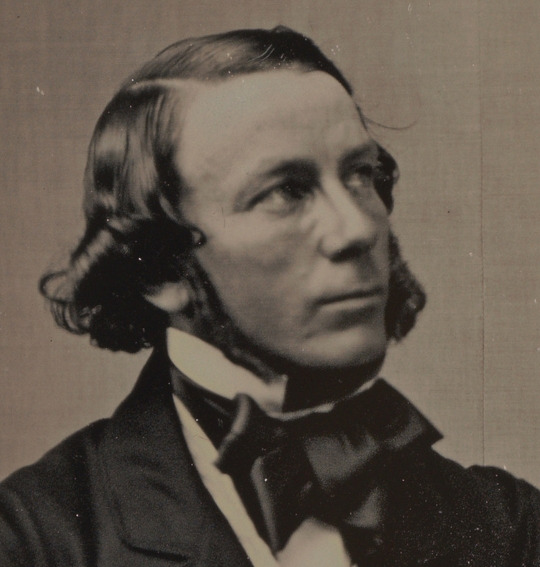
#miwackulous tye monday#1850s#tbh this look can be 1840s#but the tye pushes it into 1850s visually#historical men's fashion#daguerreotype#1854#historical hairstyles#neckwear#fashion history#victorian#early victorian era#middle-class people of this time in western europe + colonies ARE bathing regularly!#he just has a lot of product in his hair (macassar oil#and wax and who knows)
82 notes
·
View notes
Text

Franz Xaver Winterhalter (German, 1805-1873) Portrait of Princess Elizaveta Alexandrovna Tchernicheva (1826–1902), wife of Prince Vladimir Ivanovich Bariatinsky, 1859 Pushkin Museum of Fine Arts, Moscow
#real people#Franz Xaver Winterhalter#german art#german#germany#1859#1800s#art#fine art#european art#classical art#europe#european#fine arts#oil painting#europa#princess#western civilization#history#Princess Elizaveta Alexandrovna Tchernicheva#Prince Vladimir Ivanovich Bariatinsky#classical#traditional art#painting#european fashion#fashion#black hair#brunette#brown eyes#black dress
72 notes
·
View notes
Text
Time Travel Question 35: Ancient History XVI and Earlier
These Questions are the result of suggestions from the previous iteration.
This category may include suggestions made too late to fall into the correct earlier time grouping. Basically, I'd already moved on to human history, but I'd periodically get a pre-homin suggestion, hence the occasional random item waaay out of it's time period, rather than reopen the category.
In some cases a culture lasted a really long time and I grouped them by whether it was likely the later or earlier grouping made the most sense with the information I had. (Invention ofs tend to fall in an earlier grouping if it's still open. Ones that imply height of or just before something tend to get grouped later, but not always. Sometimes I'll split two different things from the same culture into different polls because they involve separate research goals or the like).
Please add new suggestions below if you have them for future consideration. All cultures and time periods welcome.
#Time Travel#Cybele#Ancient World#Trans History#Vesuvius#Pompeii#Roman Empire#Bog Mummies#Fashion History#Tyrian Purple#Bronze Age#Iron Age#Indigenous History#Egyptian Blue#Mediterranean#Mediterranean Sea#African History#Western Asian History#European History#Queer History#Epidaurus
246 notes
·
View notes
Text
The Bankara Movement (蛮カラ)


Bankara high schoolers. 1929, Kumamoto.
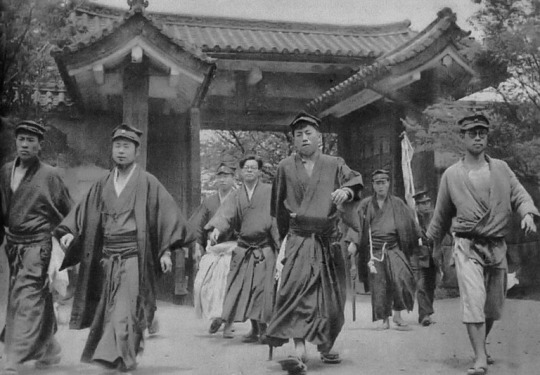
Bankara youth stride through a gate in the early post-war era. 1949, Takushoku University.

In the late 1800s, during the Meiji Restoration (1868–1912), Japan was all about modernizing, and one of the ways the government pushed this was through Western-style clothing. Men’s fashion changed first—shaved heads and topknots gave way to European-style cropped hair. By the mid-1880s, 90% of Tokyo men were rocking a fake-European “randomly cropped” look (散切り頭). Geta (wooden clogs) were swapped for regular shoes and even sneakers, while suits, hats, and ties replaced the old hakama and haori.
For Japan’s high society, wearing Western clothes became the new way of showing they were part of the Civilization and Enlightenment movement (bunmei kaika, 文明開化). The rich and powerful wanted to create a clean, modern look for Japan. By 1898, this whole push for Western fashion became known as the haikara (“high collar”) movement.
But not everyone was into it. The bankara movement grew as a response to all this Western influence. Bankara (蛮カラ) means “barbaric,” and those who followed this style rejected the fancy, foreign clothes, going for a more rugged, traditional vibe. It was especially popular with students and intellectuals who didn’t want to give up Japan’s roots.
The Tonbi Coat



At the same time, the tonbi coat showed how Japan was mixing in Western elements but making them their own. Originally based on the Inverness coat from Scotland, the tonbi was modified to fit the kimono with wide armholes and a cape. Over time, it became so tied to Japanese style that no one even thought of it as a Western thing anymore, to the point that Bankara students liked to wear the tonbi coat over their uniforms as symbol of subversion.
So, while the government was pushing for Western fashion, the bankara movement resisted, and the tonbi coat shows how Japan took some foreign ideas and turned them into something uniquely their own.
Sources: 1,2,3.

#bankara#bankara movement#蛮カラ#バンカラ#meiji era#Japanese history#fashion history#Japanese fashion history#high collar#westernization#meiji restaurantion
33 notes
·
View notes
Text






Traditional English smocks
#traditional clothing#english#european#western europe#smocks#embroidery#english smocks#smock#folk clothing#folk fashion#culture#history
16 notes
·
View notes
Text
i kinda find it really fucking gross how tankies will act like they're such huge allies to lgbtq people ackshully. because as we all know dictatorial so-called communist states were and are so tolerant of queer people protesting their rights
#political crap#not to sound like I'm implying liberalism isn't a flawed ideology here#but social liberals have led the charge for gay rights throughout history communists have only ever done it when it's fashionable#up until like the 80s the french communists called it 'a distraction from the overthrow of the capitalist system' or some bollocks#and what the maoists said about homosexuality was even worse#on a related note considering hungary czechoslovakia and afghanistan i don't think tankie ideology can ever be called anticolonial#they were just as keen on colonising as the western powers when it suited them
19 notes
·
View notes
Text
Found a really great fashion history blog run by FIT university of New York that hosts intros to a range of historical fashion eras:
#posting here for my own reference but I thought other people might be interested too!!#the intro pages mainly cover western fashion but they also have individual articles about a variety of fashion history topics#text post#reference
6 notes
·
View notes
Text

Real photo postcard of a pair of well-dressed and well-armed cowboys, c. 1910s
#the amazing aesthetic whiplash between the leather crotch lacing and the fluffy wookie chaps#I demand a historically accurate western in which our gritty hard-talkin' sharp-shootin' outlaw antihero is swaggering around in... these#early 20th century#1900s#1910s#vintage photography#rppc#real photo postcard#cowboys#vintage men#historical fashion#fashion history#men's fashion
147 notes
·
View notes
Text
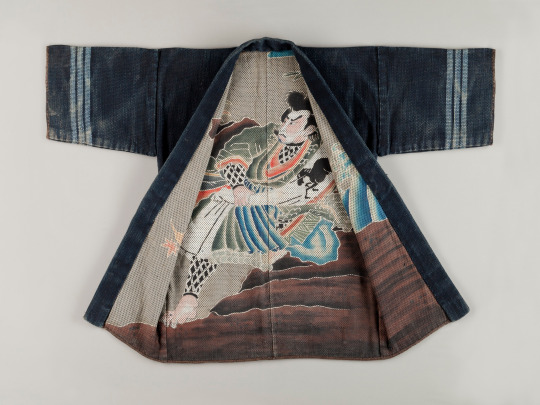
Fireman's Coat
Late 19th Century to Early 20th Century
Japan
Japanese firemen's coats are reversible. When fighting fires, the coat was worn as shown, together with close-fitting trousers, a hood, and gloves. Saturated with water, these garments gave protection against flames. A bold, legible pattern on the back identified the fireman’s brigade. For festive occasions, the pictorial side faced outward. This coat shows the Toad Spirit offering to teach the robber Jiraya magic, provided he used it only to benefit humanity.
Denver Art Museum (Accession Number: 1999.265)
#coat#outerwear#fashion history#historical fashion#non western fashion#japanese fashion#late 19th century#early 20th century#turn of the century#1880s#1890s#1900s#1910s#denver art museum
1K notes
·
View notes
Photo
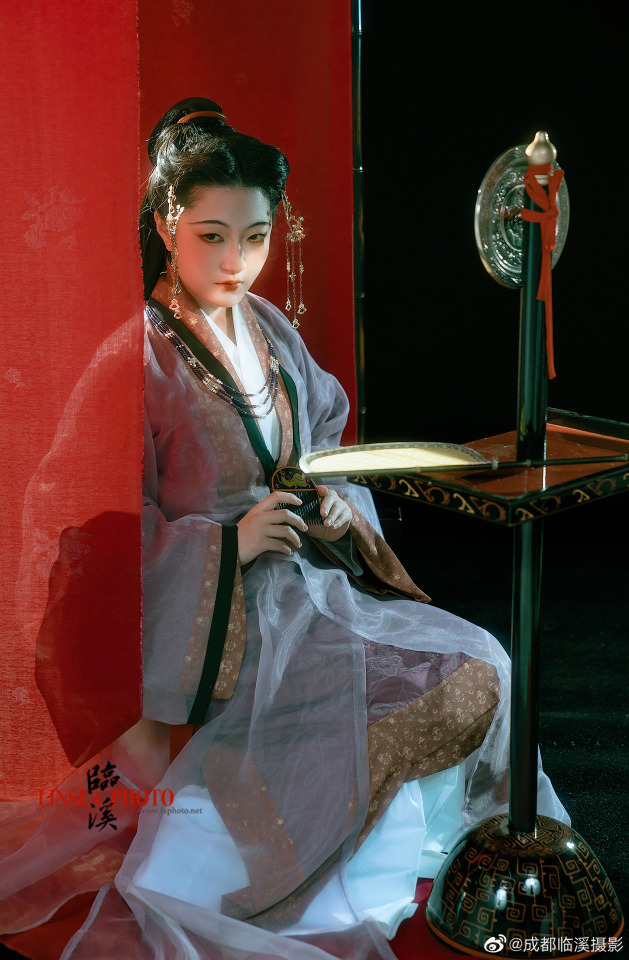
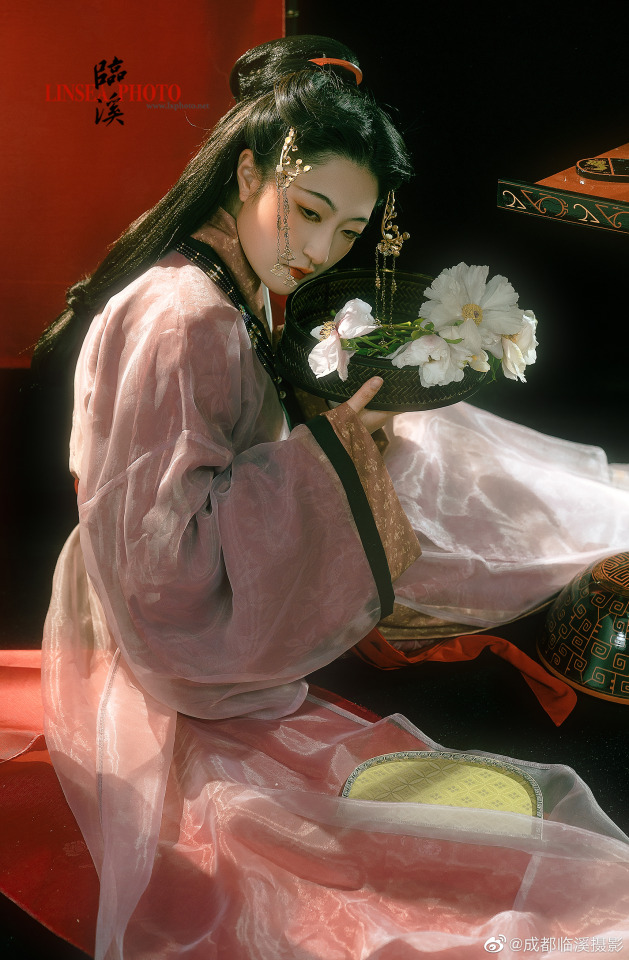
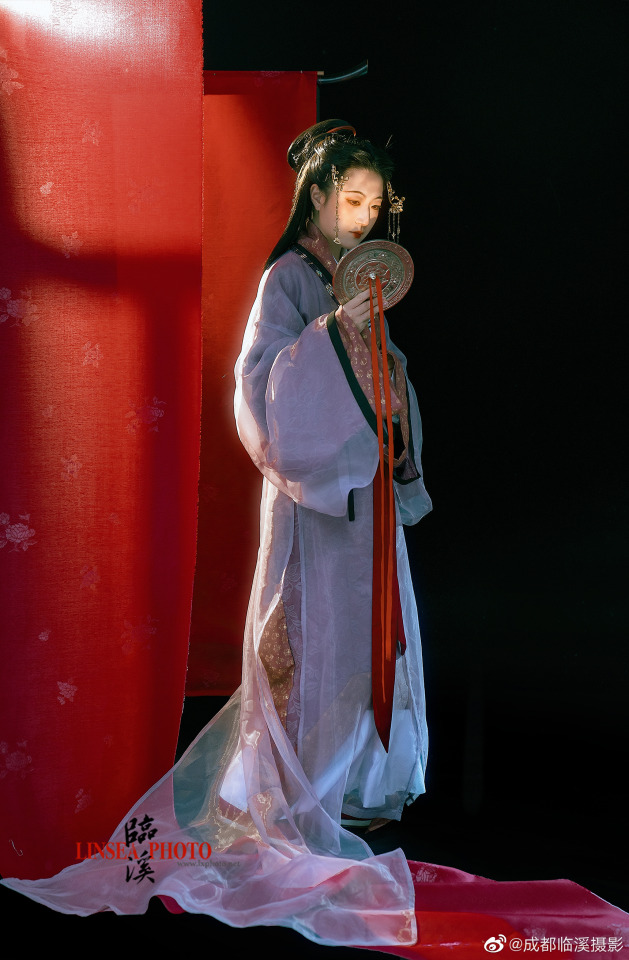
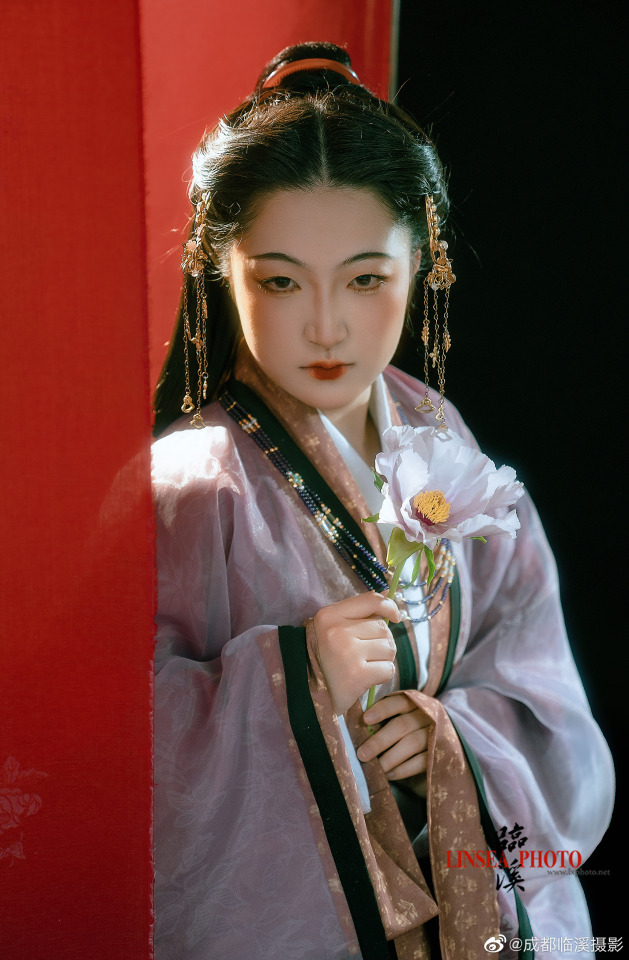
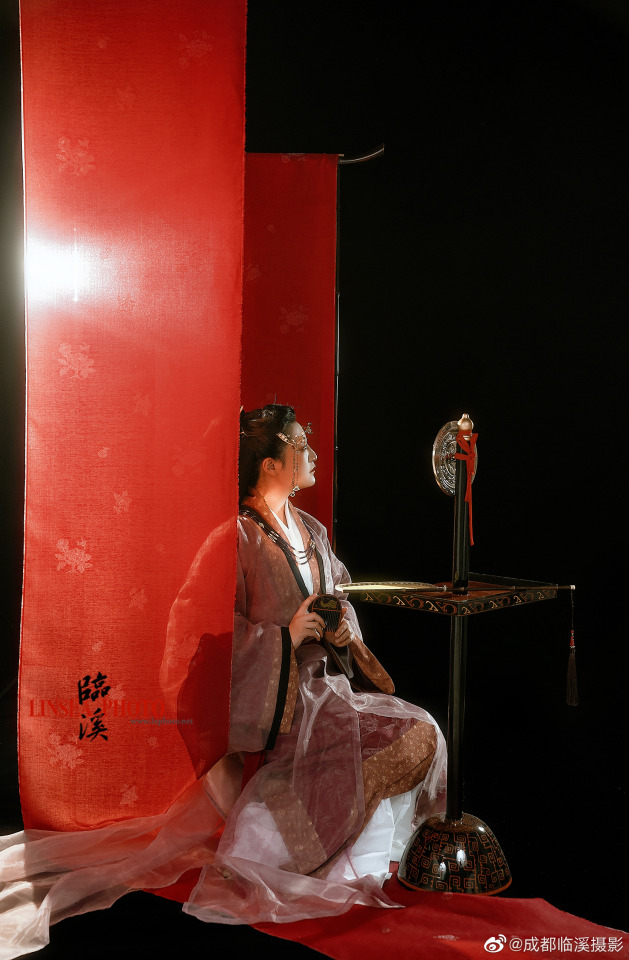
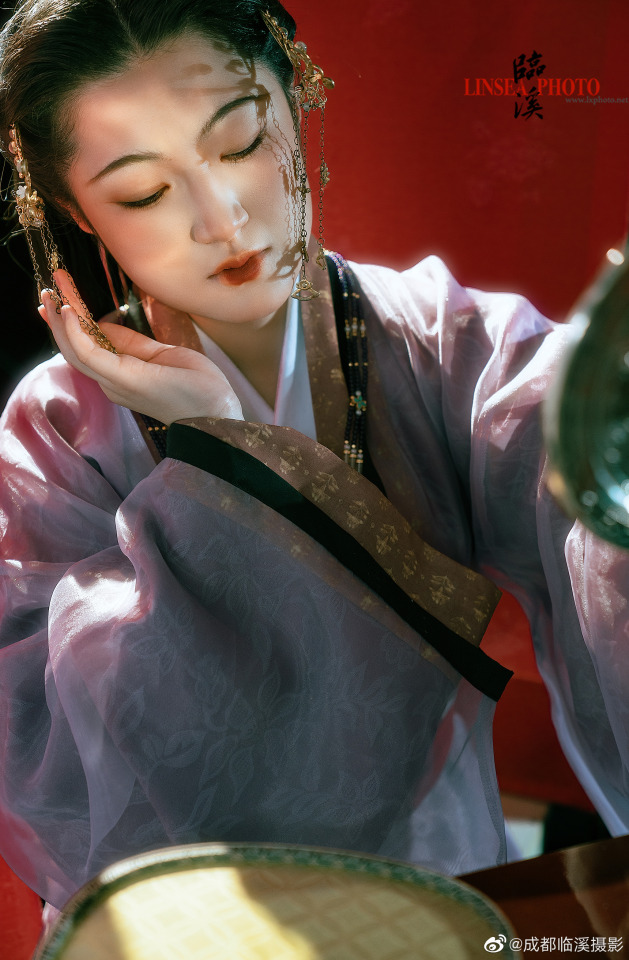
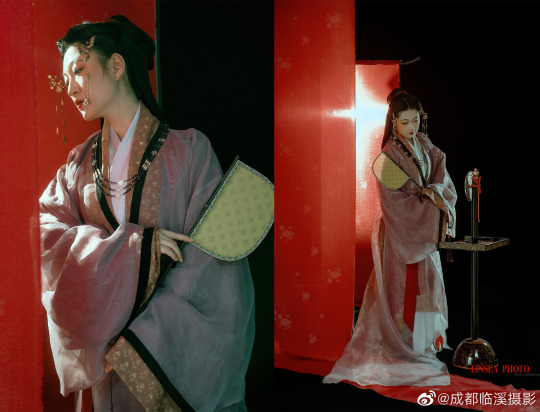
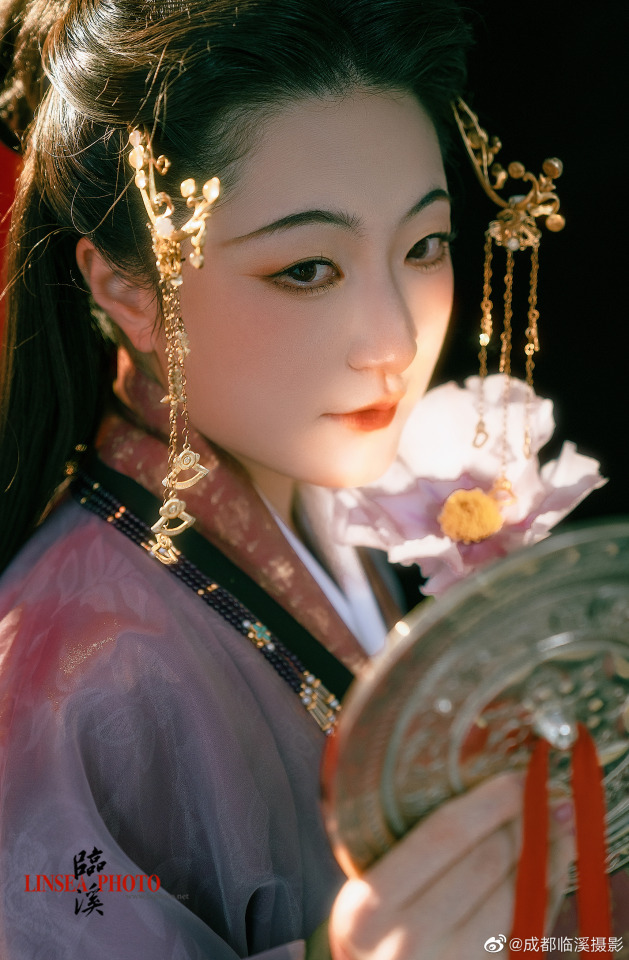
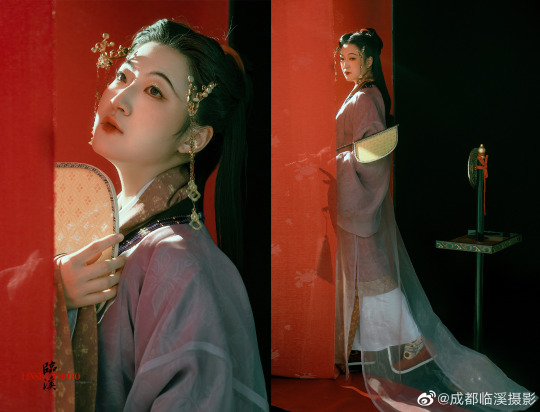
【Han Dynasty Artifact Reference】
China Western Han Dynasty Painted Female Figurines (early and middle period of Western Han)

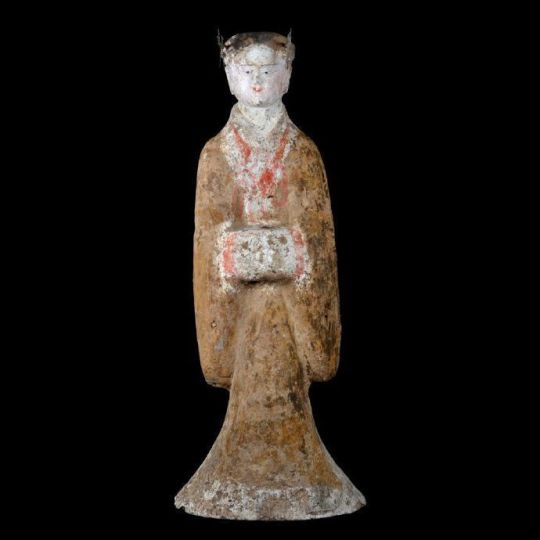
・Plain yarn garment (straight) Mawangdui No. 1 Han Tomb (Xinzhui)
material: silk,size: dress length 132 cm, sleeve length 181.5 cm

[Hanfu · 漢服]Chinese Han Dynasty Traditional Clothing Hanfu Photoshoot【风露霓裳】
_______
📝 Plan: 成都临溪摄影
📸Photo: 何力
💄Stylist: 百丽 熊熊
🧚🏻 Model: 弋歌
🔗Weibo:https://weibo.com/1648616372/N3L7fw0hT
_______
#chinese hanfu#Han Dynasty#western han dynasty#chinese history#hanfu art#hanfu#chinese traditional clothing#chinese#chinese coustume#chinese relics#hanfu accessories#chinese culture#China History#hanfu photoshoot#chinese historical fashion#漢服#汉服#成都临溪摄影#何力#百丽 熊熊#弋歌#风露霓裳
272 notes
·
View notes
Text
Neoclassicism Fashion Era, 1790–1800
A simple, high-waisted silhouette of plain white muslin defined the neoclassical look for women. This high waist is often referred to as the empire waist. Sometimes a ribbon around the waist was worn. Headbands were popular, as well as cloth bonnets, decorated straw hats and headwraps.
The graphic below actually explains it best, including what was worn underneath.


Marie-Victoire Lemoine (French, 1754–1820) • A young woman leaning on the edge of a window • 1798-99


Left: Portrait of Madame Récamier, by Jacques-Louis David, 1800
Right: Louis-Léopold Boilly (French, 1761–1845) • Point de Convention (Absolutely no agreement) • 1797


1796 and 1800 fashion plates • colored etchings
#fashion history#art#painting#art history#historical fashion#neoclassical fashion#jacques louis david#french artist#louis leopold boilly#marie victoir lemoin#late 18th century fashion#early 19th century fashion#19th century western fashion#neoclassical fashion plates#colored etchings#the resplendent outfit art & fashion blog
19 notes
·
View notes